ASUS TUF Z87 Gryphon Review
by Ian Cutress on February 3, 2014 10:00 AM EST- Posted in
- Motherboards
- Asus
- Z87
- TUF
Computational Benchmarks
Readers of our motherboard review section will have noted the trend in modern motherboards to implement a form of MultiCore Enhancement / Acceleration / Turbo (read our report here) on their motherboards. This does several things – better benchmark results at stock settings (not entirely needed if overclocking is an end-user goal), at the expense of heat and temperature, but also gives in essence an automatic overclock which may be against what the user wants. Our testing methodology is ‘out-of-the-box’, with the latest public BIOS installed and XMP enabled, and thus subject to the whims of this feature. It is ultimately up to the motherboard manufacturer to take this risk – and manufacturers taking risks in the setup is something they do on every product (think C-state settings, USB priority, DPC Latency / monitoring priority, memory subtimings at JEDEC). Processor speed change is part of that risk which is clearly visible, and ultimately if no overclocking is planned, some motherboards will affect how fast that shiny new processor goes and can be an important factor in the purchase.
Point Calculations - 3D Movement Algorithm Test
The algorithms in 3DPM employ both uniform random number generation or normal distribution random number generation, and vary in various amounts of trigonometric operations, conditional statements, generation and rejection, fused operations, etc. The benchmark runs through six algorithms for a specified number of particles and steps, and calculates the speed of each algorithm, then sums them all for a final score. This is an example of a real world situation that a computational scientist may find themselves in, rather than a pure synthetic benchmark. The benchmark is also parallel between particles simulated, and we test the single thread performance as well as the multi-threaded performance.
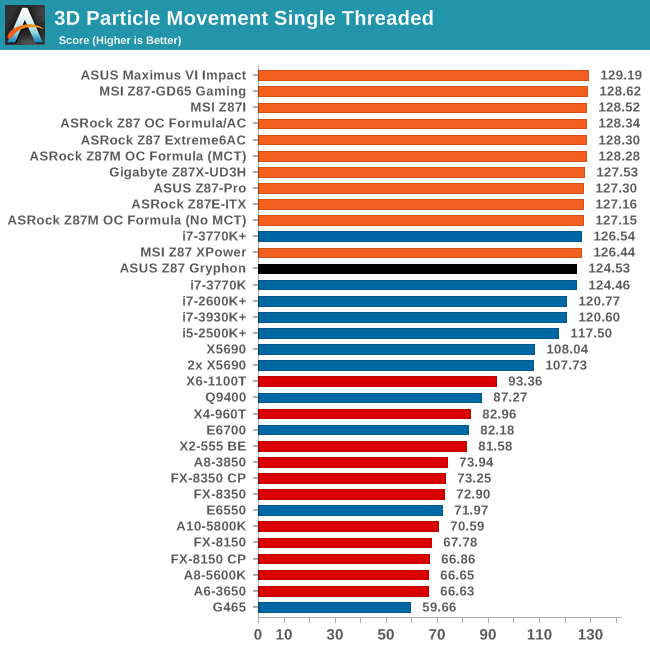
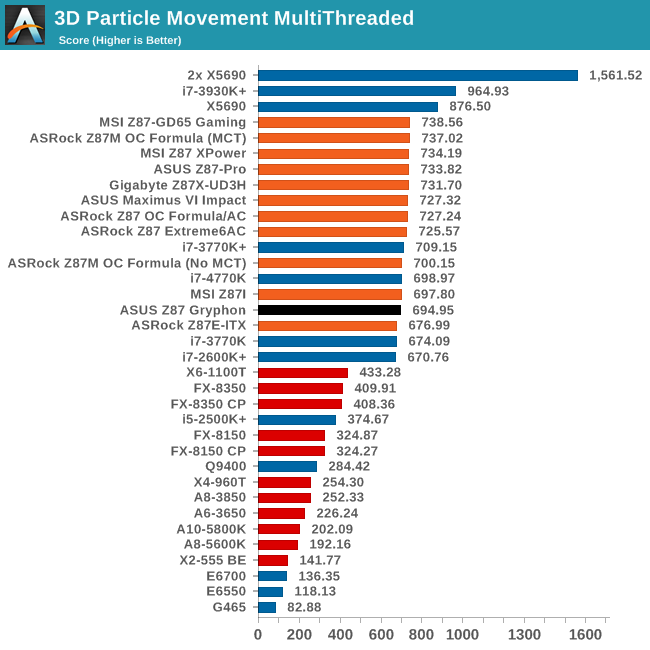
As the Gryphon does not implement MultiCore Acceleration by default, there is a small gap to the other motherboards in terms of performance, especially during multi-threading. There is a small discrepancy in terms of single thread efficiency too.
Compression - WinRAR 4.2
With 64-bit WinRAR, we compress the set of files used in the USB speed tests. WinRAR x64 3.93 attempts to use multithreading when possible, and provides as a good test for when a system has variable threaded load. WinRAR 4.2 does this a lot better! If a system has multiple speeds to invoke at different loading, the switching between those speeds will determine how well the system will do.
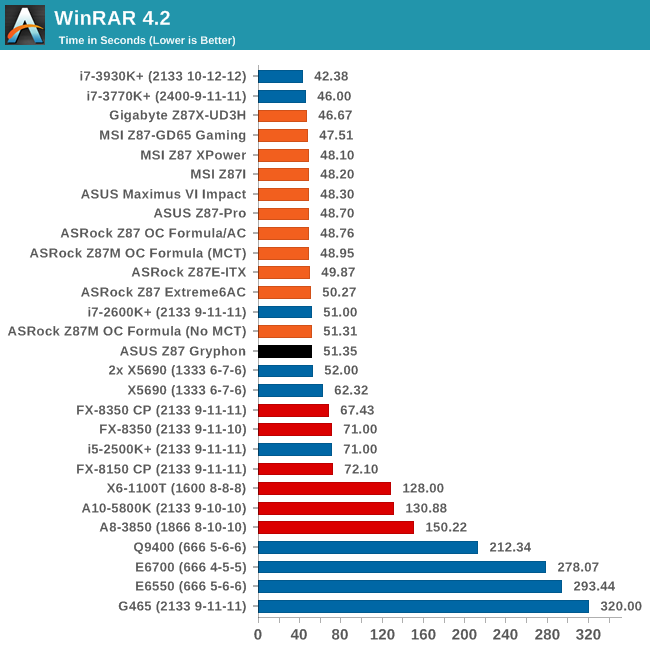
Some Z87 motherboards are in the sub-50 second range, but due to the variable threaded nature of WinRAR the Gryphon does not hit that mark.
Image Manipulation - FastStone Image Viewer 4.2
FastStone Image Viewer is a free piece of software I have been using for quite a few years now. It allows quick viewing of flat images, as well as resizing, changing color depth, adding simple text or simple filters. It also has a bulk image conversion tool, which we use here. The software currently operates only in single-thread mode, which should change in later versions of the software. For this test, we convert a series of 170 files, of various resolutions, dimensions and types (of a total size of 163MB), all to the .gif format of 640x480 dimensions.
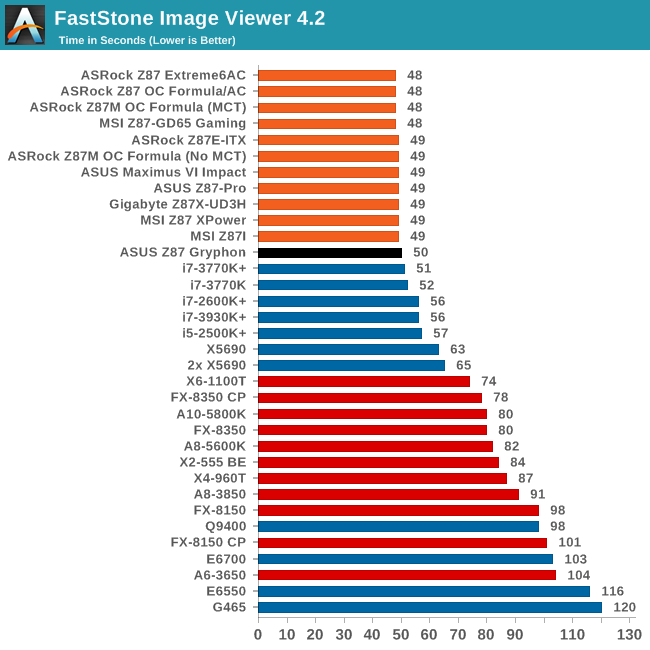
For whatever reason, the Gryphon falters slightly in our FastStone test. Either it took a little time to ramp up or was flickering in and out of Turbo during in the test.
Rendering – PovRay 3.7
The Persistence of Vision RayTracer, or PovRay, is a freeware package for as the name suggests, ray tracing. It is a pure renderer, rather than modeling software, but the latest beta version contains a handy benchmark for stressing all processing threads on a platform. We have been using this test in motherboard reviews to test memory stability at various CPU speeds to good effect – if it passes the test, the IMC in the CPU is stable for a given CPU speed. As a CPU test, it runs for approximately 2-3 minutes on high end platforms.
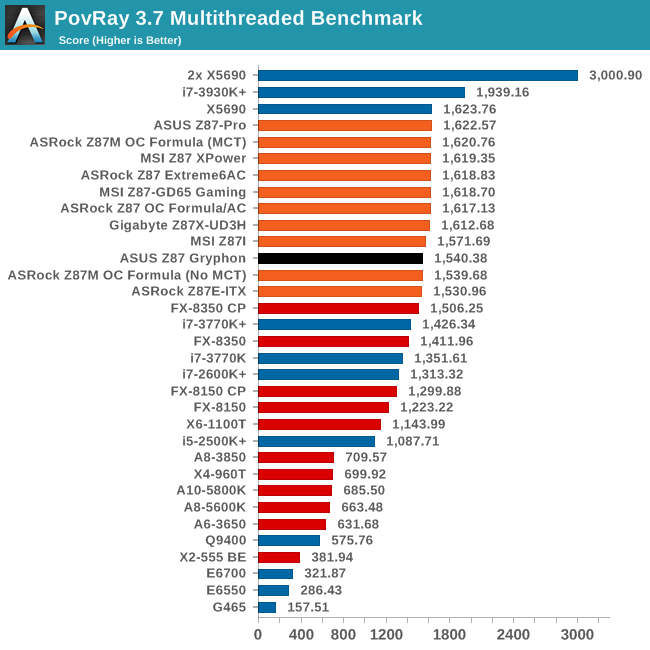
The Gryphon matches our other non-MCT motherboards in PovRay.
Video Conversion - x264 HD Benchmark
The x264 HD Benchmark uses a common HD encoding tool to process an HD MPEG2 source at 1280x720 at 3963 Kbps. This test represents a standardized result which can be compared across other reviews, and is dependent on both CPU power and memory speed. The benchmark performs a 2-pass encode, and the results shown are the average of each pass performed four times.
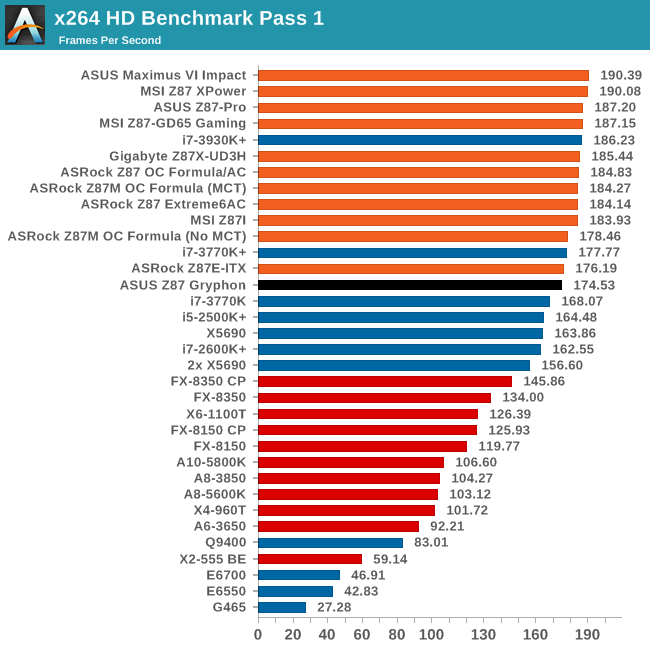
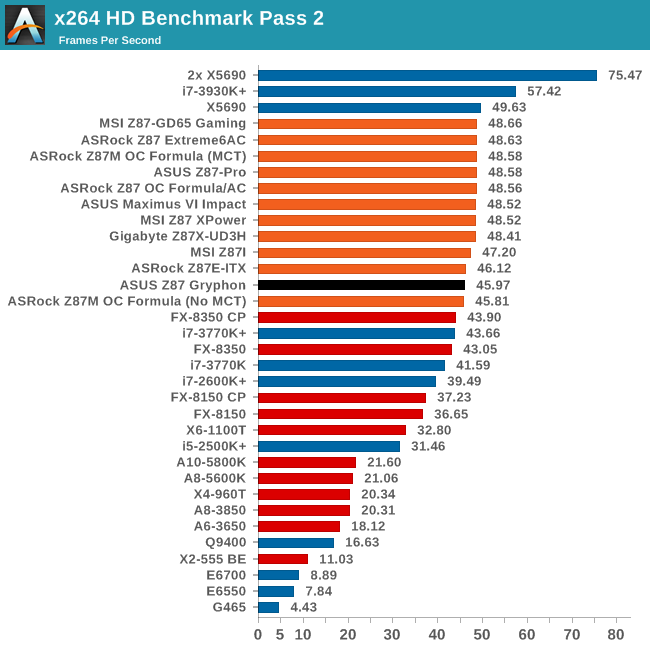
Grid Solvers - Explicit Finite Difference
For any grid of regular nodes, the simplest way to calculate the next time step is to use the values of those around it. This makes for easy mathematics and parallel simulation, as each node calculated is only dependent on the previous time step, not the nodes around it on the current calculated time step. By choosing a regular grid, we reduce the levels of memory access required for irregular grids. We test both 2D and 3D explicit finite difference simulations with 2n nodes in each dimension, using OpenMP as the threading operator in single precision. The grid is isotropic and the boundary conditions are sinks. Values are floating point, with memory cache sizes and speeds playing a part in the overall score.
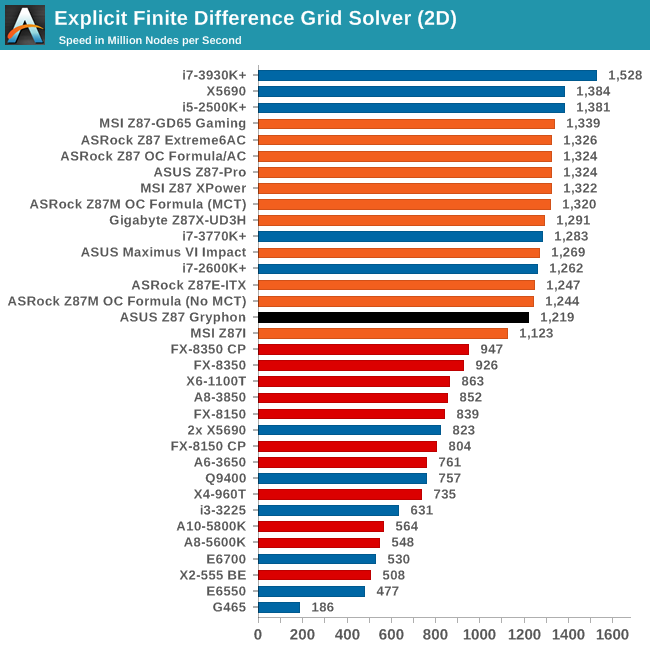
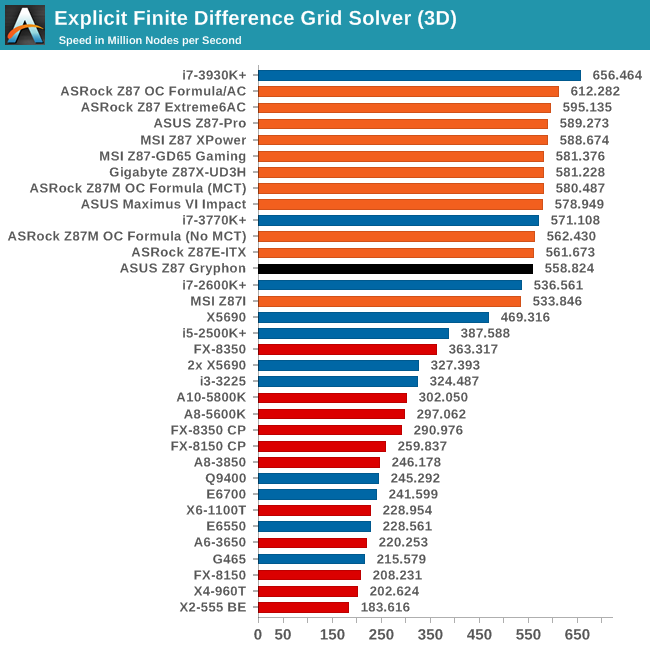
Despite no MCT, our Explicit Finite Difference testing showed preference for the Gryphon over the MSI Z87I.
Grid Solvers - Implicit Finite Difference + Alternating Direction Implicit Method
The implicit method takes a different approach to the explicit method – instead of considering one unknown in the new time step to be calculated from known elements in the previous time step, we consider that an old point can influence several new points by way of simultaneous equations. This adds to the complexity of the simulation – the grid of nodes is solved as a series of rows and columns rather than points, reducing the parallel nature of the simulation by a dimension and drastically increasing the memory requirements of each thread. The upside, as noted above, is the less stringent stability rules related to time steps and grid spacing. For this we simulate a 2D grid of 2n nodes in each dimension, using OpenMP in single precision. Again our grid is isotropic with the boundaries acting as sinks. Values are floating point, with memory cache sizes and speeds playing a part in the overall score.
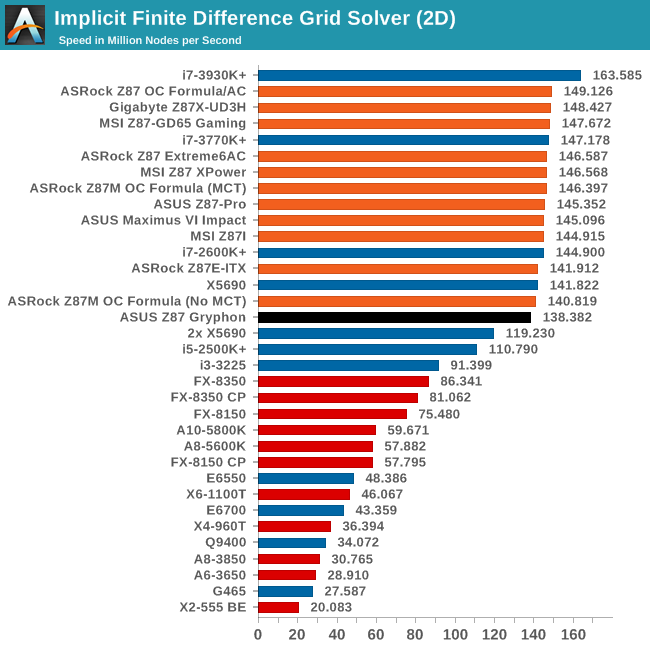
Point Calculations - n-Body Simulation
When a series of heavy mass elements are in space, they interact with each other through the force of gravity. Thus when a star cluster forms, the interaction of every large mass with every other large mass defines the speed at which these elements approach each other. When dealing with millions and billions of stars on such a large scale, the movement of each of these stars can be simulated through the physical theorems that describe the interactions. The benchmark detects whether the processor is SSE2 or SSE4 capable, and implements the relative code. We run a simulation of 10240 particles of equal mass - the output for this code is in terms of GFLOPs, and the result recorded was the peak GFLOPs value.
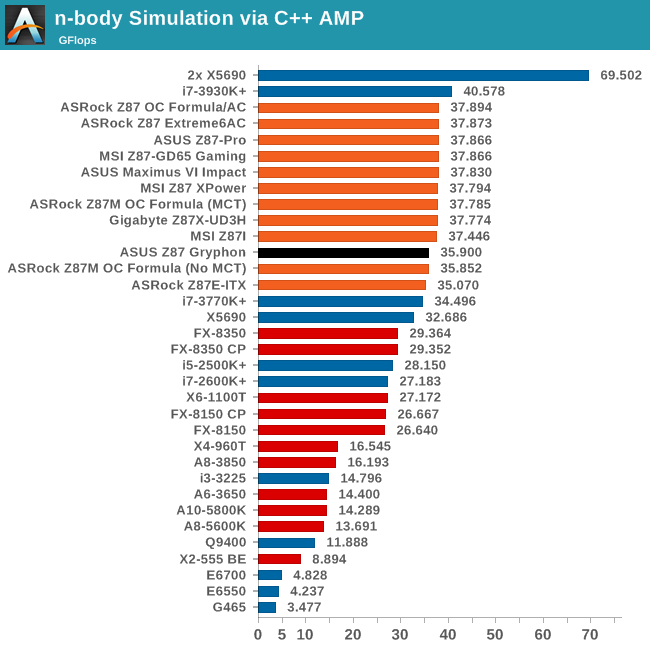










62 Comments
View All Comments
FractinJex - Monday, February 3, 2014 - link
Im currently running this board in a CoolerMaster N200 mATX build and its awesome! Just like the sabertooth its rock solid and built to last until upgrade 4-5 years...i7 4770
MSI GTX 780 Ti 1225mhz
8gb 2400 Gskill
AX860
Firestrike score - 11313
tim851 - Monday, February 3, 2014 - link
>its rock solid and built to last until upgrade 4-5 years...<Yeah, unlike all the normal motherboards that explode after 3 years... *rollseyes*
5thaccount - Monday, February 3, 2014 - link
Yeah, haha, all my systems last far beyond 5 years - but that's because I refuse to use ASUS motherboards! ASUS hasn't made quality motherboards for 15 years. Every month I see hundreds of ASUS motherboards thrown out because they died or have some problems. MSI also has a high failure rate, but unlike ASUS, they actually honor their warranty.munim - Monday, February 3, 2014 - link
Yeah, haha, all my systems last far beyond 5 years - but that's because I refuse to use MSI motherboards! MSI hasn't made quality motherboards for 15 years. Every month I see hundreds of MSI motherboards thrown out because they died or have some problems. Asus also has a high failure rate, but unlike MSI, they actually honor their warranty.maximumGPU - Tuesday, February 4, 2014 - link
Love it!Senti - Monday, February 3, 2014 - link
Why so much hate towards Asus to even spam the same nonsense (zero examples) from multiple accounts?Asus does make nice boards, just a bit overpriced maybe.
My oldest MB still in use is Asus K8N4-E Deluxe: that's 8 years of use (with overclocking too)! Just had to replace CMOS battery recently.
FractinJex - Monday, February 3, 2014 - link
They are both trolls....I handle multiple MB vend/manf. on a daily basis and Asus is still one of the best consumer/enthusiast brands available simply as that....MSI is right up there as well with their xpower etcEtsp - Monday, February 3, 2014 - link
munim isn't supporting 5thaccount, they are pointing out how ridiculous 5thaccount's post is, by using the same exact wording and swapping the brands.Samus - Monday, February 3, 2014 - link
Lmfao is this guy serious? Asus has always made some of the best motherboards going way back to the 80's.5thaccount - Tuesday, February 4, 2014 - link
My hate is strictly for ASUS' motherboards and RMA process. Everything else I've seen from ASUS has been of reasonable to excellent quality. 'munim' is someone not related to me. I'm not going to give specific examples or identify myself, but since the 90s I've worked as a technician, at very large reseller (at one time was the largest reseller of video cards in the world - although we sold every other part too), and currently at an electronics recycling company. I see things on an enormous scale and from a unique perspective. We see tons of the latest technology running through our doors, and ASUS motherboards are a running joke (from my experience their reliability has been spotty since their Socket A / 462 boards - prior to that they were bulletproof). Anyhow, no one has to believe a word of what I just said - won't affect me one way or the other.